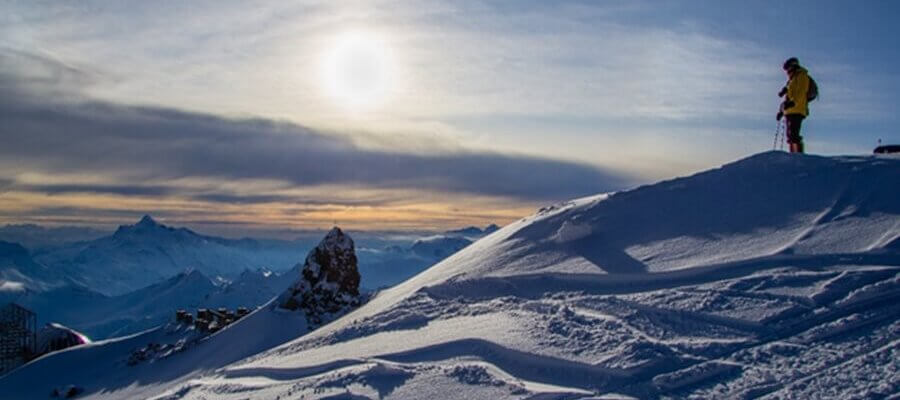Every summer, thousands of foreigners flood into the Caucasus Mountains of Russia to climb Mt. Elbrus, Europe’s highest peak. At first glance, the obvious route to climb is the South Route, the most popular of options among climbers (i.e. 80-90% of climbers choose the South Route). With that being said, the North Route is growing in popularity because of its more remote feel and being 100% on foot. So, which route should you take? Let’s compare and contrast and see which one you prefer!
1. Accessibility
-South Route – The drive to the base of Mt. Elbrus from the local MRV airport (Mineralni Vodi) is approx. 3-3.5 hrs. This drive is one of the most well-traveled tourist routes in the North Caucasus, and as a result is very safe and pretty well-maintained (including a new federal highway bypassing Pyatigorsk to/from the airport, finished in 2019). If you need to rent a kit/gear for your climb, there are multiple rental shops in the 3 tourist “towns” at the base of Elbrus: Azau, Terskol, and Cheget. Your stay in Cheget/Azau will be for 2 or 3 nights depending on your itinerary, sleeping at 6,900-7,500 feet above sea level (2100-2300 meters), before moving up to base camp.
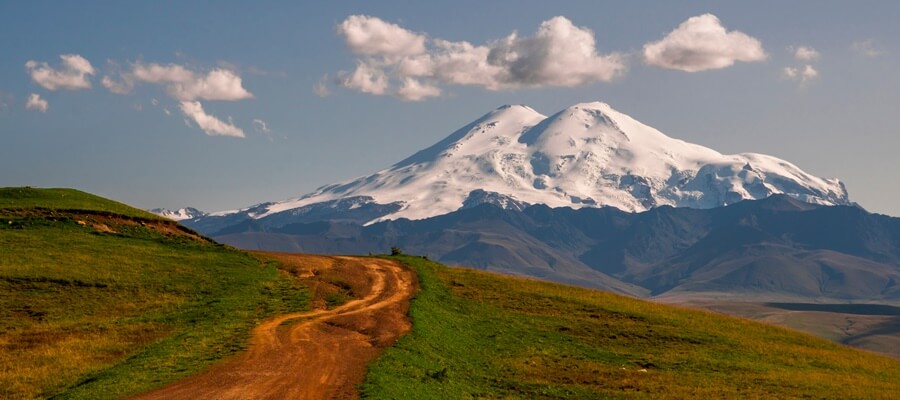
-North Route – You’ll also have a 3-3.5 hr. drive to base camp on the North Side, in one of the Caucasus’ most picturesque locations, Djili-Suu. But, you’ll likely spend your first night in the city of Kislovodsk, as there are no gear rental shops at the North Side Base camp. Gear will be rented in Pyatigorsk on the way to Kislovodsk. On Day 2, you’ll head to Base camp at 8200 feet above sea level (2600 meters). The road to the North Side Base camp is paved until the last 5-7 km (dirt road), so typically only off-road vehicles will make this drive.
Most Accessible route? Slight nod to the South Route, as the roads are better and gear can be rented at the base of the mountain.
2. Convenience
-South Route – Without a doubt, the South Route is the more convenient and comfortable way to climb Mt. Elbrus. Here are several conveniences of the South Route (but not limited to), that the North Route doesn’t have:
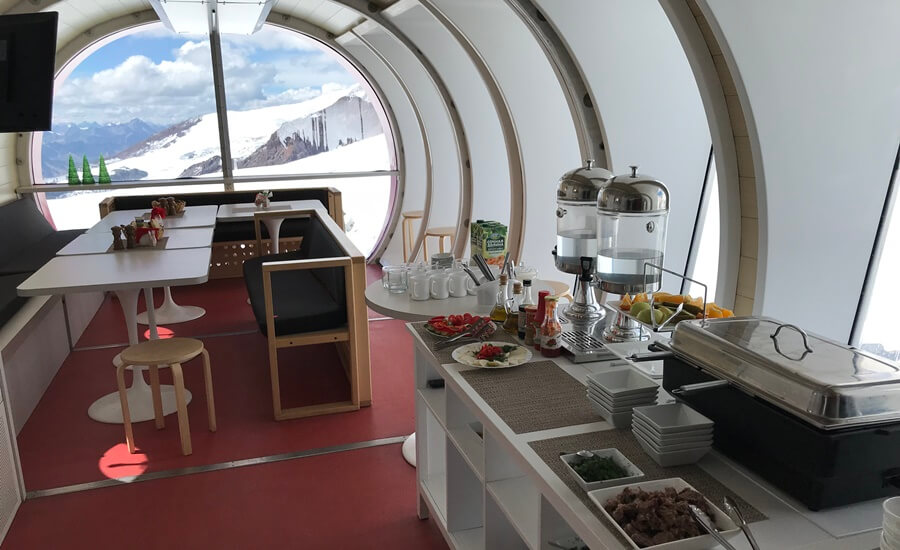
- 4-star hotels – While naturally there are 2-star and 3-star hotels at the base of Mt. Elbrus, there are several quality 4-star hotels tucked into this beautiful corner of the Caucasus Mountains. These hotels have very nice Russian Banya and/or Turkish/Finnish Sauna services. You will spend your first 2-3 nights of acclimatization in a traditional hotel as well as your final 1-2 nights post-climb, depending on when your summit takes place. As a result, sleeping in tents on the South Route is not really an option, as some may have expected after summiting Kilimanjaro.
- WiFi – In your hotels at the bottom of Elbrus plus at base camp, you’ll have access to WiFi and/or a decent cell connection. This is esp. true in the VIP Leaprus Barrel Huts (i.e. WiFi). This way, you can be in touch with your loved ones as well as address any urgent work matters that come up while you’re away. This also makes a difference with your guide having constant access to the weather prognosis, and being well-informed to make the game-time decision on which day (and what time) to attempt your summit (***Very important to your summit success!). Note: Aside from Leaprus, most other barrel hut providers do not have WiFi but receive intermittent cell service.
- ATM – There is an ATM at the bottom of Elbrus (Terskol), which can be handy for a number of things: personal gear rental, buying souvenirs, going for a horseback ride after your summit, experiencing a Russian banya, etc. There’s no ATM available on the North Route (i.e. after Day 1, once you’re on the mountain). The bottom of Elbrus has a myriad of entertainment options to spend money at that the bottom of the North route doesn’t: coffee shops, karaoke bars, etc. While we recommend you bring enough cash with you to Mt. Elbrus in case the ATM isn’t working, it’s a nice back-up in case you need to make an extra withdrawal.
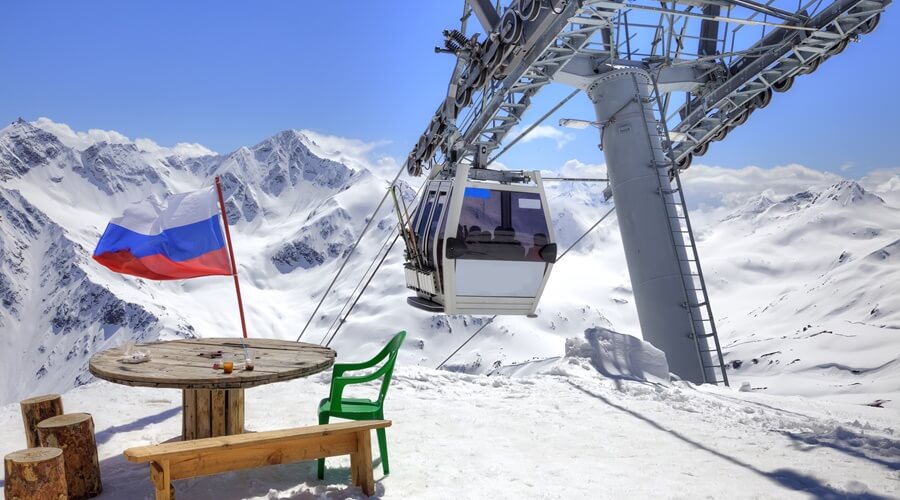
- Ski lifts – What many don’t know about Mt. Elbrus, is that it’s one of Russia’s premier ski resorts from November – May each year. As a result, there are ski lifts carrying climbers from the bottom of the mountain all the way to base camp on Day 3-4 of your climb. The reasons for this are the following:
- Scenery – When not covered with snow, the actual ski slopes of Elbrus are not very pleasing to the eye. In fact, Elbrus isn’t actually a mountain, it’s a dormant volcano. As a result, you’ll notice the slopes from the bottom of the South Route up to Base Camp look distinctly volcanic in their texture. You’ll do one or two acclimatization hikes to around 10,000 ft. (3,100 m) on Days 2/3 in more beautiful areas surrounding Mt. Elbrus (Cheget, Irikchat, etc.), before taking the ski lifts on Day 3/4 to base camp.
- No porters – The ski lifts eliminate the need for porters on the South Route, as many climbers have previously experienced on Kilimanjaro. You’ll load your gear onto the lift with you, and be transported quickly up to your new home at base camp.
- Running Water at Base Camp – Leaprus Barrel Huts, the nicest accommodation at Base Camp, is loved by its guests for its bathrooms with real sinks and toilets (i.e. not an outhouse)! This is a luxury at 12,800 feet (3,900 meters) and available for those choosing our 4-star accommodations. 3-star accommodations also have above-average living conditions in the Heart of Elbrus Lodge, but the toilet and bathroom situation (i.e. outhouse) is more on par with other base camps around the world.
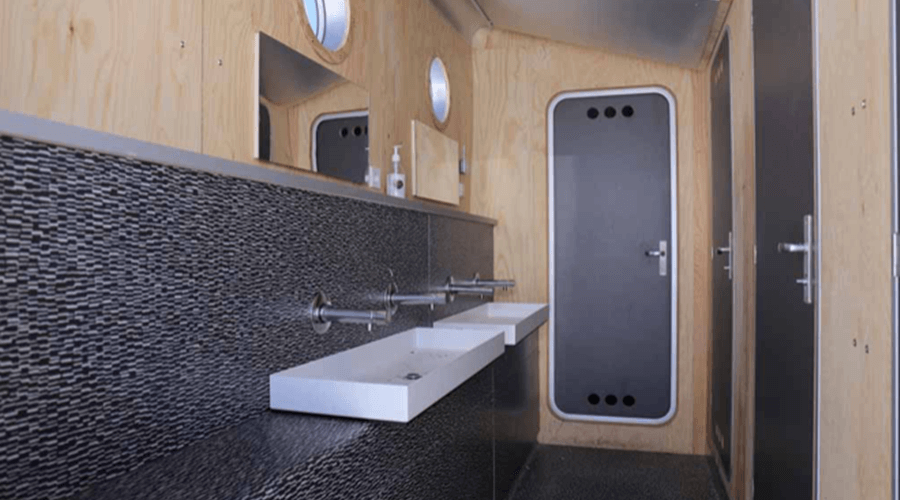
- SnowCat on Summit Day – Elbrus is well-known for its snowcats, which are available to be used by climbers on their summit ascent AND descent, for those willing to pay. There are a lot of misunderstandings about the SnowCats, so here is a basic overview of why they exist:
- Maximizes your chance of success – The snowcats can save climbers that extra window of time (and save their strength) to allow them to get up and down the mountain successfully. Between tight weather windows and a demanding summit day (10-14 hrs. of non-stop hiking), the snowcats play a big role in the South Route’s high success rate.
- Covering ground you’ve already climbed – Many climbers ask this question: “Am I cheating if I take the snowcat on Summit Day?” On your acclimatization climb two days before your summit attempt, you will climb from 12,500 ft. (3,800 m) to 15,400 ft. (4,700 meters), to the famous Pastukhov Rocks. This is where the Snowcat will drop you off on Summit morning, if you choose to use it. It’s covering ground you’ve already climbed once. You can imagine the amount of strength (and time) it will save you driving those 3,000 ft. (900 meters) in elevation on summit morning (about 2 hrs. of hiking).
- Most groups use them – Approx. 80-90% of groups use the Snowcats on Summit Day. Only particularly strong groups (often smaller, private groups who all know each other’s level of strength) climb the entire South Route without the Snowcats.
- Follow Your Guide’s Lead – Your local guide at Elbrus wants you to summit the mountain successfully. He/she will have a good feel for your group dynamic after 5-6 days with you, and will talk you through your options for Summit morning, and whether or not to use the SnowCat. Trust their lead and experience. They will likely recommend you to take the Snowcat to maximize your chance of summiting. This is normal. We highly recommend you plan for this in your budget.
- Cash payment on the spot – Typically, groups will pay the SnowCat driver in cash, on the spot, for his services. If ascending to 15,400 ft. (4700 m), budget $100 (USD) for this. There is even the option to ascend to 16,700 ft. (5100 m) (amount to be agreed on with driver). Snowcats will also be available on the descent back to base camp, for those exhausted at the end of their descent, or for those escaping potential bad afternoon storms moving in (cost to be agreed on with driver on the spot).
-North Route – If convenience is important to you, the North Route is NOT the way for you to climb Mt. Elbrus. BUT, if a remote, off-the-grid, authentic mountaineering experience is what you’re looking for, then the North Route may be just for you:
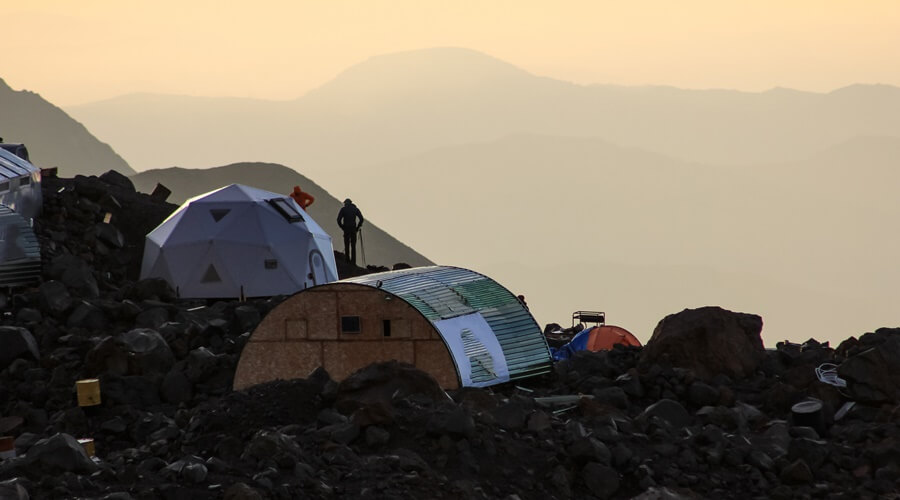
- NO 4-star hotels – While you can stay in a 4-star hotel (and 2/3-star hotels) in Kislovodsk on the first and last night of your journey to the North Side of Elbrus, the actual climb portion of your trip involves no hotels, only mountain shelters. So enjoy that hot shower on your first night while you have it, because you’re heading into the wild for 8 days after that!
- NO WiFi – None of the mountain shelters at the lower camp (8200 ft., 2600 m) or higher camp (12,100 ft., 3,700 m) have WiFi. As a result, you’re significantly less connected to the rest of the world. The intermittent cell connection limits how often your guide can check the weather in the days leading up to your summit attempt, making it a bit more difficult to judge any last-minute changes in the prognosis.
- NO ATM – Once you leave Kislovodsk on the morning of Day 2, you won’t have access to an ATM, as there is no tourist infrastructure at base camp besides mountain shelters.
- NO ski lifts – It’s a 100% trek on foot from base camp to the summit. Porters are available for hire in lower camp if you want the help in transporting your things to higher camp on one of your acclimatization hikes.
- NO Snowcat on Summit Day – While this may make some mountaineers happy, do remember that this significantly increases the amount of time it will take to summit Mt. Elbrus, not to mention the amount of energy that will be required. The success rate on the North Route is lower than on the South Route, one main reason being because there is no Snowcat to cover that extra amount of ground for climbers at the start of the climb.
So which route is more convenient? The South Route, by a landslide. If you like the idea of 4-star hotels, wifi, and indoor toilets, then definitely choose the South Route. Maybe you’re not looking for convenient, though, but more rugged and challenging. If that is you, then the North Route should fit you better.
3. Length of Climb
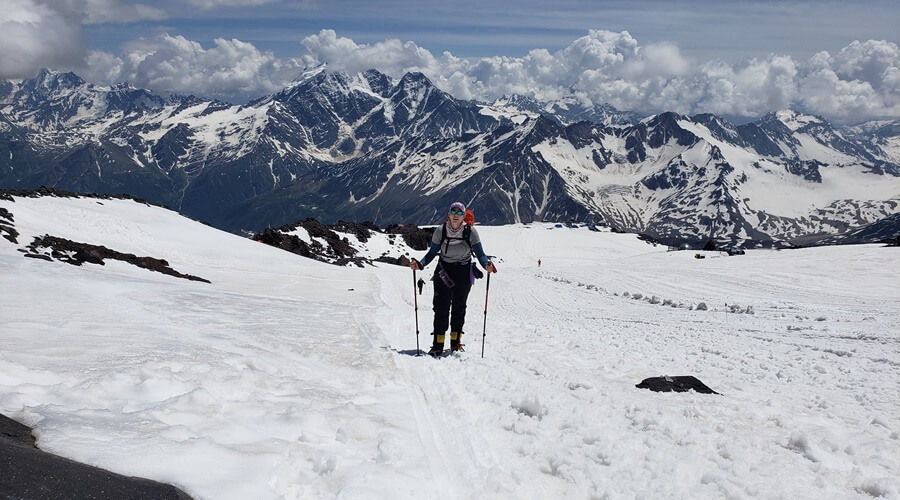
-South Route – The standard length of a climbing itinerary on the South Route, from start to finish, should fall between 8-10 days. Most local Russian climb operators, run standard 8-day itineraries; we highly recommend not trying to climb Mt. Elbrus in less than an 8-day window. With that being said, you will find some Western climbing companies which maximize acclimatization and summit reserve days, stretching the itinerary to 10 days long. Here is how the South Route itinerary plays out practically:
-Day 1 – Arrival to MRV airport, 3 hr. transfer to Mt. Elbrus (6,900 ft, or 2,100 m)
-Day 2 – Acclimatization hike to 10,000 ft. and back (3,100 m), gear rental for base camp
-Day 3 – Transition with gear up ski lifts from bottom of Elbrus to base camp (12,500 ft., or 3,800 m). For groups with a 9-10 day itinerary, you’ll likely add an extra acclimatization hike day on Day 3
-Day 4 – Acclimatization hike to Pastukhov Rocks, Crampon/Ice Axe/Rope Training (15,400 ft., 4,700 m). For groups with a 9-10 day itinerary, you’ll take the ski lifts up to base camp today
-Day 5 – Rest Day, Acclimatization, Technical Skills Training
-Day 6 – Summit Day – Weather-permitting, this is the day you’ve been waiting for – Snowcat ride to 15,400 ft. (4,700 m), then a long ascent to 18,510 ft. (5,642 m) and back down to base camp
-Day 7 – Reserve Day – If you summited successfully yesterday, your group will take the ski lifts back to the bottom of Elbrus this morning, for a final free afternoon and celebratory dinner – If due to weather or altitude sickness today is your summit day, you’ll rise extra early for your summit, to ensure you catch the ski lifts back down the mountain (3:30 pm final departure) before they close. Groups with a 9-10-day itinerary will have their first scheduled summit attempt today
-Day 8 – Departure home – You’ll make the 3-hr. drive to the MRV airport this morning to catch a flight back to Moscow/St. Petersburg for further touring, or for your flight home tonight or tomorrow. For groups with a 9-10-day itinerary, Day 8 is your 1st summit reserve day, or departure down the mountain if you summited successfully on Day 7
-Day 9 – Groups with a 9-day itinerary will fly home today, and groups with a 10-day itinerary use Day 9 as a 2nd reserve day, maximizing their summit attempts in case of particularly nasty weather
-Day 10 – Departure home
-North Route – The standard length of a climbing itinerary on the North Route, from start to finish, should fall between 10-11 days. It’s about a 50/50 split of climbing companies that use 10-day and 11-day itineraries. Most local Russian climb operators, run standard 11-day itineraries; we highly recommend not trying to climb the North Route with less than a 10-day window. Here is the standard 11-day North Route Itinerary:
-Day 1 – Arrival to MRV airport, 1 hr. transfer to Kislovodsk, with potential stop in Pyatigorsk to rent climbing gear (additional 2 hrs.)
-Day 2 – 2.5 hr. transfer from Kislovodsk to Djili-Suu, North Side Base Camp, (8,200 ft., or 2,600 m)
-Day 3 – Acclimatization hike to 10,200 ft. (3,100 m) – For groups with 10-day itineraries, they will hike to the upper camp today and leave part of their gear there
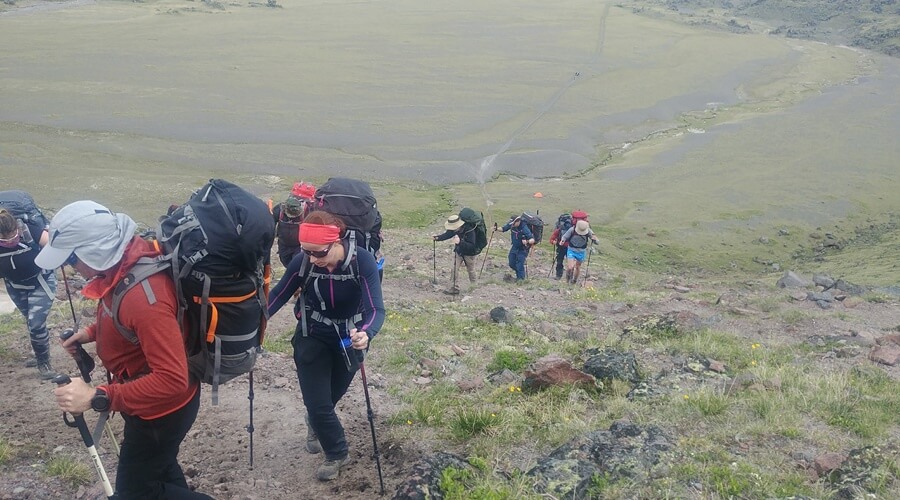
-Day 4 – Acclimatization hike to Upper Base Camp, leave most of your gear there, return to lower base camp to overnight (8,200 to 12,100 ft., 2600 m to 3700 m – Porters available for hire)
-Day 5 – Acclimatization hike to Upper Base Camp with remaining gear, officially move to upper camp
-Day 6 – Acclimatization hike to Lenz Rocks (12,100 ft. to 15,100 ft., 3700 to 4600 m)
-Day 7 – Rest Day, Acclimatization, Technical Skills Training – For groups with 10-day itineraries, weather-permitting, today is Summit Day
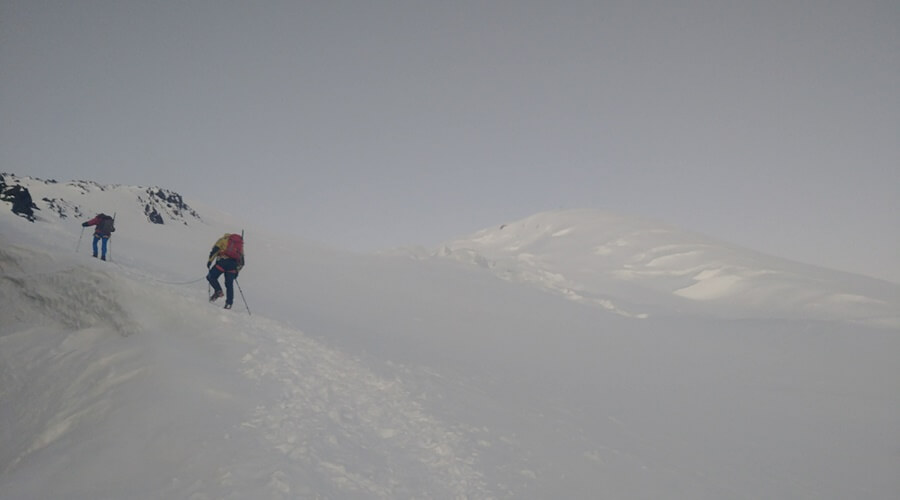
-Day 8 – Summit Day – Weather-permitting, this is the day you’ve been waiting for – Very early departure, likely between 11:00 pm – Midnight, then a long summit to 18,510 ft. (5,642 m) and back down to base camp – For groups with a 10-day itinerary, Day 8 is your 1st summit reserve day, or departure back down to lower camp if all went well on Day 7
-Day 9 – Reserve Day – If you summited successfully yesterday, your group will head back down to lower camp today – If not summiting yesterday because of inclement weather or altitude sickness, you’ll go for the summit this morning! – Groups with a 10-day itinerary will leave Lower Camp today and return to Kislovodsk for a hot shower and final celebratory meal/evening
-Day 10 – For groups who summited on Day 8 and spent last night at lower camp, you’ll head back to Kislovodsk today for a free afternoon and final celebratory evening/meal – Groups who summited yesterday, will descend from upper camp to lower camp today, and then drive back to Kislovodsk late afternoon – Groups with a 10-day itinerary will be transferred to the MRV airport and fly back home today
-Day 11 – Departure home – You’ll be transferred to the MRV airport for the next leg of your journey: Moscow/St. Petersburg touring, or your international flight home
For length of climb, there is no real advantage to either route unless you are on a tight schedule. If this is the case, the South Route gives a bit more leeway to the climber, with a potential 8-day itinerary. Climbers can do this entire trip in 9 days from the UK, arriving home on the same day as leaving the Caucasus, whereas climbers from the US/Canada can manage it in 10 days if planning it right. While the North Route is longer, this may be a better fit for you if you’re wanting more time on the mountain and away from your normal routine. Your call!
4. Difficulty of ascent
The North Route is without a doubt a more difficult climb from start to finish than the South Route, from acclimatization to summit day. Here are some of the reasons why:
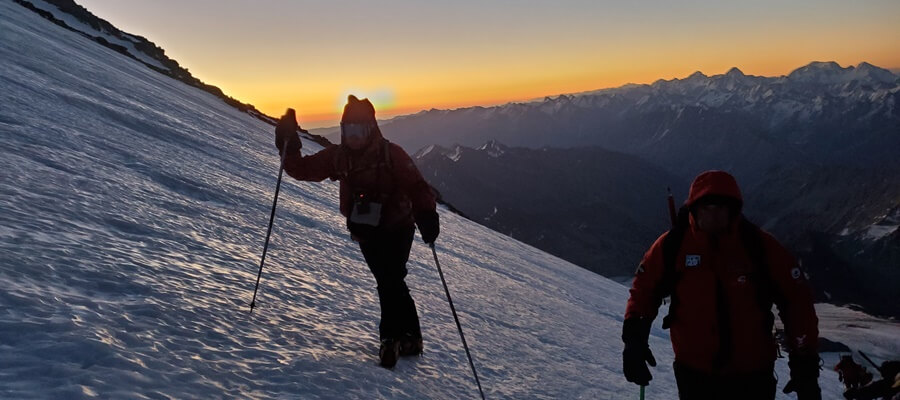
- Convenience Factor – The North Route has no real entertainment or overtly “comfort” option in accommodations as compared to the South Route’s 4-star hotels, WiFI, tourist infrastructure, and VIP base camp huts, and as a result may leave the climber feeling a bit more uncomfortable throughout their climb. This of course is subjective, as some climbers may feel more prepared for their summit because of the focus pure mountain conditions require.
- Ski Lifts – On Day 3/4 of the South Route itinerary, the climber will ride from 7,500 to 12,500 ft. on the ski lifts, essentially not having to carry their heavy packs at all. In fact, for every acclimatization hike on the South Route, climbers should never have to carry more than 15 lbs. on their back. This is compared to the North Route, where climbers will carry their gear/packs on their backs from 8,200 to 12,100 ft. on Day 4/5 (this hike will be done twice)….i.e., there are no ski lifts on the North Route. Note: Porters ARE available for hire on these days if you’d like to pay for the extra help with carrying your gear to upper camp.
- SnowCat and Length of climb – On Summit Day on the South Route, climbers have the advantage of covering the first 3,000 ft. of their climb riding a Snowcat (and part of the descent as an option). This saves time and energy. On the North Route, there are no snowcats, and so climbers must climb all 6,410 ft. to the summit on their own (and back down). This makes for a significantly longer and more tiring summit day on the North Route. The lack of snowcats on the North Route requires an earlier Summit Day start with a smaller weather window than the South Route as well. In fact, the total amount of hiking required on the North Route is approx. 30 miles (50 km), compared to 16-21 miles (25-33 km) on the South Route.
- Technical aspects of the climb – Climbers tend to be opinionated about which route is more difficult, but both routes have similar skills that climbers must master: climbing with crampons, how to use an ice axe, using fixed ropes. Both sides of the mountain are steep, as you would expect from Europe’s highest peak.
Between the lack of convenience, no ski lifts or snowcats, and a significantly longer summit day, the North Route is definitely the more difficult ascent to the top of Elbrus.
5. Safety
While often Mt. Elbrus is labeled as one of the “easiest” of the Seven Summits, let’s not forget that there are very real dangers when climbing a mountain of this magnitude. Fatalities do happen on the mountain on an annual basis. Almost all fatalities can be attributed to climbers attempting a summit WITHOUT a local guide, unfortunately. We highly stress the importance of summiting with a local guide, both on the South or North Route. The reasons for this are threefold:
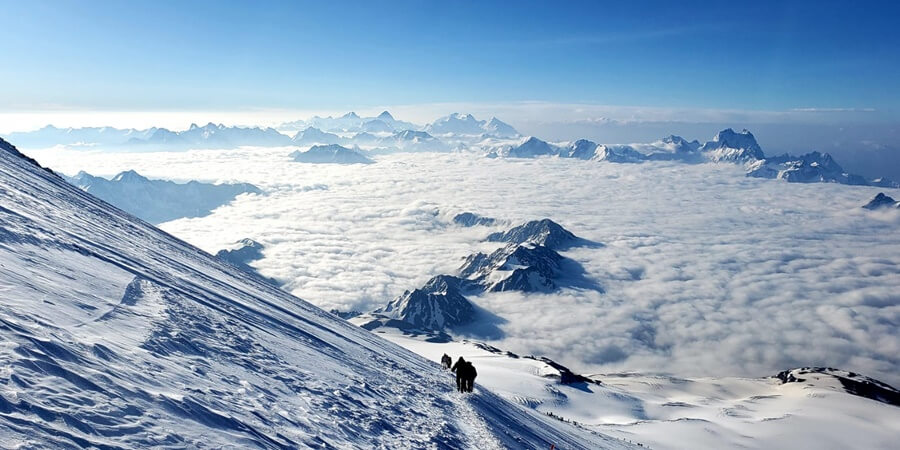
- Weather – Local guides are very experienced in knowing when it’s safe to summit, and when it’s better to wait a day. Without having input like this from a local guide, climbers may unknowingly get stuck in a sudden snowstorm, hurricane-like winds, fog, lightning, hail, etc. Anything can happen when conditions like this on the mountain strikes, and so it’s better to avoid them if at all possible.
- Altitude sickness – Climbing at such a high altitude can bring on sudden bouts of altitude sickness. Without the input or decision-making of a guide who has already been acclimatized for several weeks or months, climbers’ judgment can become clouded, they may become disoriented, and can get lost or be unable to radio for help in their moment of need.
- Familiarity with the mountain – Often when one of the two above factors strikes (i.e. bad weather or altitude sickness), climbers may become disoriented and start ascending/descending in the wrong direction. This is a recipe for disaster on Elbrus, where there are huge glaciers and crevasses. Having a local guide ensures climbers will stay on the safest path possible.
Guide or no guide aside, there are a few factors that make the South Route a bit safer in emergency situations. This is a big advantage of the conveniences of the South Route. These factors are:
- Snowcats and ski lifts – If a climber is injured and his/her guide radioes Rescue Services for help, or it’s 4:00 pm and some independent climbers haven’t returned to their huts (all climbers are required to register their presence and planned summit day with Rescue Services), Rescue Services can move quickly up and down the mountain on the SnowCats (up to 16,400 ft.) to find/help the injured, or lost, climber. If the ski lifts have already been turned off (by 3:30 pm), they can be turned back on to transport an injured climber down to the bottom of the mountain and to a local hospital. There are no snowcats or ski lifts on the North Route, and as a result it takes Rescue Services longer to locate and transport climbers (on foot) back down to upper (and lower) camp, as well as to a local hospital (by car).
- Helicopter services – Helicopter rescue services are available at Mt. Elbrus if a climber has insurance, and can pick the injured climber up from the mountain, and transport them directly to the Pyatigorsk hospital where their injuries can be tended to. This is available on both the South and North Route.
If having to choose, the availability of the ski lifts and snowcats makes the South Route a bit safer than the North.
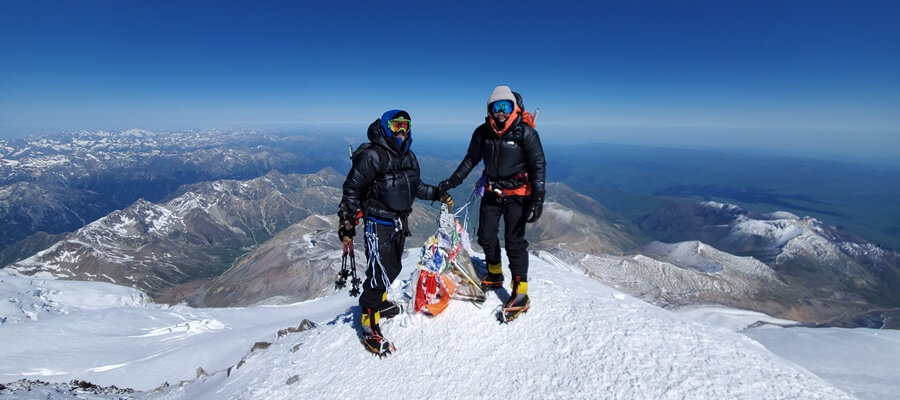
So what do you think? Which route is more appealing to you to climb? While some may prefer the South Route with its shorter itinerary and extra conveniences and comfort, others may prefer the North Route with its more remote locales and doing the entire climb on foot from start to finish. Whatever you prefer, we can help you achieve your goal of summiting Europe’s highest peak successfully. Reach out today to learn more about climbing Mt. Elbrus!

